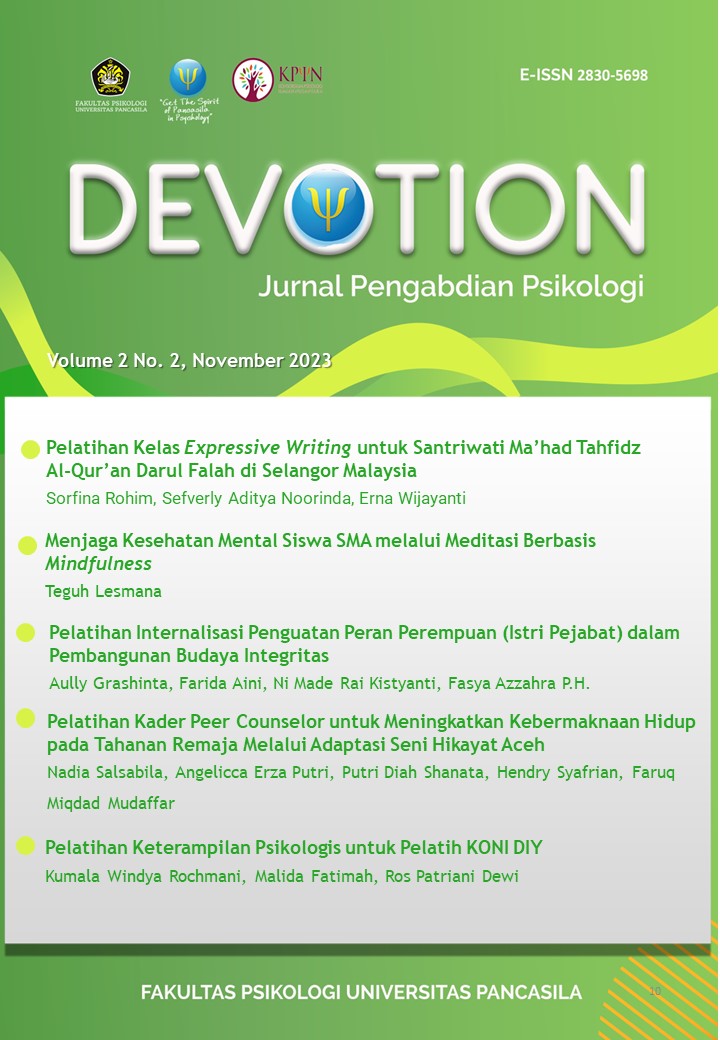Meditasi Mindfulness Guna Meningkatkan Mindfulness Siswa SMA Sebagai Cara Menjaga Kesehatan Mental
Mindfulness Meditation to Improve High School Students' Mindfulness as a Way to Maintain Mental Health
Abstract
Difficulties and challenges in the lives of teenagers who are in the transition period to adulthood, if they are not equipped with good adaptability, will cause problems with teenagers' mental health. One of the factors that influences teenagers' mental health is a feeling of gratitude. Regarding this gratitude factor, an approach that can be used to increase feelings of gratitude in teenagers is a mindfulness approach. Mindfulness is considered suitable for high school students because mindfulness is something that is applied in everyday life. In this research, what we want to prove is the role of mindfulness meditation in increasing high school students' mindfulness. The research subjects consisted of 92 Atisa Dipamkara High School students in grades 10 and 11. The method used was a quantitative research method that used SPSS for the data processing program. The design used is quasi-experimental research, a one-group pre-test post-test design. The measuring instrument used is the Mindfulness Attention Awareness Scale (MAAS), which has been adapted into Indonesian. The research results showed that there was a significant difference between before and after the mindfulness meditation training was given. Thus, the mindfulness meditation provided has been proven to significantly increase mindfulness in high school students.
References
Alidina, S. (2020). Mindfulness For Dummies (3rd ed.). John Wiley & Sons, Inc.
Baer, R. A., Smith, G. T., Hopkins, J., Krietemeyer, J., & Toney, L. (2006). Using self-report assessment methods to explore facets of mindfulness. Assessment, 13(1), 27–45. https://doi.org/10.1177/1073191105283504
Basso, J. C., McHale, A., Ende, V., Oberlin, D. J., & Suzuki, W. A. (2019). Brief, daily meditation enhances attention, memory, mood, and emotional regulation in non-experienced meditators. Behavioural Brain Research, 356, 208–220. https://doi.org/10.1016/j.bbr.2018.08.023
Brown, K. W., & Ryan, R. M. (2003). The Benefits of Being Present: Mindfulness and Its Role in Psychological Well-Being. Journal of Personality and Social Psychology,84(4), 822–848. https://doi.org/10.1037/0022-3514.84.4.822
Carr, P. (2023). The Roles of Mindfulness and Gratitude on Life Satisfaction The Roles of Mindfulness and Gratitude on Life Satisfaction. View project. March. https://doi.org/10.13140/RG.2.2.32900.60808/2
DelMonte, M. M. (2011). Mindfulness and awareness: Constructivist, psychodynamic and eastern perspectives. International Journal of Mental Health and Addiction, 10(3), 311–329. https://doi.org/10.1007/s11469-011-9368-8
Didonna, F. (2009). Clinical Handbook of Mindfulness. In Clinical Handbook of Mindfulness (1st ed.). Springer.
Fleischmann, R., & Posner, M. (2020). Meditation for Increased Mindfulness and Memory: An Analysis on the Impact of Meditation on Mindfulness and Working Memory Capacity in High School Students. Journal of Student Research, 9(2), 1–17. https://doi.org/10.47611/jsrhs.v9i2.1079
Hardianti, R., Erika, E., & Nauli, F. A. (2021). Hubungan Antara Rasa Syukur Terhadap Kesehatan Mental Remaja Di Sma Negeri 8 Pekanbaru. Jurnal Ners Indonesia, 11(2), 215. https://doi.org/10.31258/jni.11.2.215-227
Kaligis, F., Ismail, R. I., Wiguna, T., Prasetyo, S., Indriatmi, W., Gunardi, H., Pandia, V., & Magdalena, C. C. (2021). Mental health problems and needs among transitional-age youth in Indonesia. International Journal of Environmental Research and Public Health, 18(8). https://doi.org/10.3390/ijerph18084046
Kümmerle, S., Heidenreich, T., & Müller-Engelmann, M. (2023). Beyond Mindfulness Assessed by Questionnaires: The Mindful-Breathing Exercise as an Additional Approach in PTSD and Depression. Mindfulness, 14(4), 919–932. https://doi.org/10.1007/s12671-023-02093-9
Langer, E. J. (2014). Mindfulness 25th Annivesary Edition (2nd ed.). Da Capo Press.
Lesmana, T. (2017). Hubungan Antara Mindfulness Dan Pembelian Impulsif Pada Remaja Perempuan Yang Melakukan Shopping Online. Psibernetika, 10(2), 81–91. https://doi.org/10.30813/psibernetika.v10i2.1044
Lesmana, T. (2018). Correlation on Mindfulness, Self Esteem and Impulsive Buying Among Female Online Shopper. The Asian Conference on Psychology & the Behavioral Sciences, May, 1–17.
Lesmana, T., & Bidangan, L. (2021). The Effect of Academic Self-Efficacy and Mindfulness on Students Academic Stress During the Covid-19 Pandemic Period. Proceedings of the International Conference on Economics, Business, Social, and Humanities (ICEBSH 2021), 570(Icebsh), 91–95. https://doi.org/10.2991/assehr.k.210805.014
Lesmana, T., & Elgin, M. (2020). Hubungan Mindfulness dan Kecenderungan Aggressive Driving pada Pengendara Motor Usia Dewasa Awal di Jakarta. Prosiding Seminar Nasional, 176–183. http://ejurnal.mercubuana-yogya.ac.id/index.php/ProsidingPsikologi/article/view/1370
Lesmana, T., & Yunita, M. M. (2020). Stres sebagai mediator antara mindfulness dan frekuensi merokok pada individu dewasa awal di Jakarta. Jurnal Psikologi Ulayat, 8, 28–42. https://doi.org/10.24854/jpu139
Liu, Y., Liu, Y., & Wang, C. (2022). The Effect of Mindfulness Meditation on Academic Performance of Students. Proceedings of the 2021 International Conference on Public Art and Human Development ( ICPAHD 2021), 638(Icpahd 2021), 56–61. https://doi.org/10.2991/assehr.k.220110.012
Martel, A., & Fuchs, D. C. (2017). Transitional Age Youth and Mental Illness – Influences on Young Adult Outcomes. Child and Adolescent Psychiatric Clinics of North America, 26(2), xiii–xvii. https://doi.org/10.1016/j.chc.2017.01.001
McKenzie, S., & Hassed, C. (2012). Mindfulness For Life (1st ed.). Exile Publishing.
Rahmawaty, F., Silalahiv, R. P., T, B., & Mansyah, B. (2022). Faktor-Faktor Yang Mempengaruhi Kesehatan Mental Pada Remaja. Jurnal Surya Medika (JSM), 08(03), 276–281. https://doi.org/10.46815/jk.v12i1.125
Sutanto, S. H., & Immanuela, G. (2022). Mengenal Mindfulness Bagi Siswa SMA (Understanding Mindfulness for High School Students). Jurnal Pengabdian Psikologi Devotion, 1(1), 12–20.
Tang, Y.-Y., Hölzel, B. K., & Posner, M. I. (2016). Traits and states in mindfulness meditation. Nature Reviews Neuroscience, 17(1), 59. https://doi.org/10.1038/nrn.2015.7
Tang, Y.-Y., & Tang, R. (2020). Personality and meditation. The Neuroscience of Meditation, 15–36. https://doi.org/10.1016/b978-0-12-818266-6.00003-4
Yunita, M. M., & Lesmana, T. (2019). Hubungan Mindfulness Dan Vigor Dengan Prestasi Akademik Pada Mahasiswa Di Universitas X. Proyeksi, 14(2), 172. https://doi.org/10.30659/jp.14.2.172-184
Yusainy, C., Chan, D. K. C., Hikmiah, Z., & Anggono, C. O. (2019). Physical activity in Indonesian University students: the contradictory roles of dispositional mindfulness and self-control. Psychology, Health and Medicine, 24(4), 446–455. https://doi.org/10.1080/13548506.2018.1546015
Yusainy, C., Hikmiah, Z., Sofhieanty, C., & Ibrahim, M. (2019). Deception in Negotiation: The Predicting Roles of Envy and Individual Differences. ANIMA Indonesian Psychological Journal, 33(4), 203–212. https://doi.org/10.24123/aipj.v33i4.1794
Yusainy, C., Ilhamuddin, I., Ramli, A. H., Semedi, B. P., Anggono, C. O., Mahmudah, M. U., & Ramadhan, A. R. (2018). Between Here-and-Now and Hereafter: Mindfulness Sebagai Pengawal Orientasi Terhadap Kehidupan Dan Ketakutan Terhadap Kematian. Jurnal Psikologi, 17(1), 18. https://doi.org/10.14710/jp.17.1.18-30









